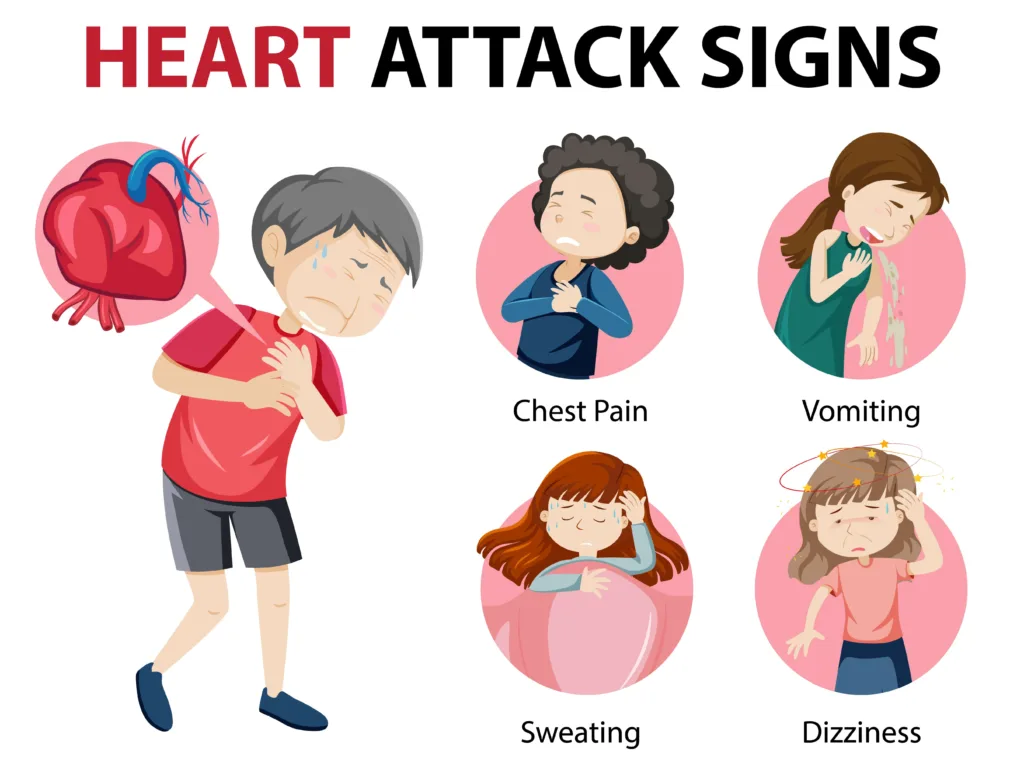What is Heart Attack ?
It is very important to know what is heart attack and how it happens. A heart attack is a life-threatening medical emergency that requires immediate treatment. If someone is feeling chest discomfort, chest pain, sudden shortness of breath, dizziness, and discomfort in upper body then it may be a major sign of heart attack. And it happens when blood flow to the heart suddenly becomes blocked. Without the blood coming in, the heart can’t get oxygen. If not treated quickly, the heart muscle begins to die. But if you do get quick treatment, you may be able to prevent or limit damage to the heart muscle. That’s why it’s important to know the symptoms of a heart attack.
Symptoms of Heart Attack
The most common symptoms in men and women are:
Chest discomfort. It is often in center or left side of the chest. It usually lasts more than a few minutes. It may go away and come back. It can feel like pressure, squeezing, fullness, or pain. It also can feel like heartburn or indigestion.
Shortness of breath. Sometimes this is your only symptom. You may get it before or during the chest discomfort. It can happen when you are resting or doing a little bit of physical activity.
Discomfort in the upper body. You may feel pain or discomfort in one or both arms, the back, shoulders, neck, jaw, or upper part of the stomach.
You may also have other symptoms, such as nausea, vomiting, dizziness, and lightheadedness. You may break out in a cold sweat. Sometimes women will have different symptoms then men. For example, they are more likely to feel tired for no reason.

Causes
The most common cause of heart attacks is coronary artery disease (CAD). With CAD, there is a buildup of cholesterol and other material, called plaque, on their inner walls or the arteries. This is atherosclerosis. It can build up for years. Eventually an area of plaque can rupture (break open). A blood clot can form around the plaque and block the artery.
A less common cause of heart attack is a severe spasm (tightening) of a coronary artery. The spasm cuts off blood flow through the artery.
Small plaques in your arteries may not block your blood vessels, but they can break open or their outer layer can wear away.
Risk Factors
Unhealthy Lifestyle habits, such as:
- Smoking, an unhealthy diet, including eating too many foods high in saturated fat or sodium
- Lack of regular physical activity
- High blood sugar or diabetes
- Other medical conditions, such as:
- High blood cholesterol, High blood triglycerides
- Overweight and obesity, High blood pressure
- If you have three or more of these conditions that raise your risk for heart disease, it is called metabolic syndrome. This greatly increases your risk of a heart attack.
- Risk factors you can’t control
- Age: The risk of heart disease increases for men after age 45 and for women after age 55 (or after menopause).
- Family history of early heart disease: You have a higher risk if your father or a brother was diagnosed with coronary artery disease before 55 years of age or if your mother or a sister was diagnosed with coronary artery disease before 65 years of age.
- Infections from bacteria and viruses
Diagnosis and Treatments
At the hospital, doctors make a diagnosis based on your symptoms, blood tests, and different heart health tests. Treatments may include medicines and medical procedures such as coronary angioplasty. After a heart attack, cardiac rehabilitation and lifestyle changes can help you recover.
How it can be prevented
Yes, you can prevent it by adopting Healthy lifestyle changes, including heart-healthy eating, stay physically active, quitting smoking, managing stress, and maintaining a healthy weight, can help you to prevent heart disease. Even if you already have coronary artery disease, these changes can lower your risk of a heart attack. You can lower your risk of a heart attack by changing behaviors that can raise your risks or treating any known coronary artery disease.
Also, it is important for you to get treatment for other health conditions that can raise your risk of a heart attack.